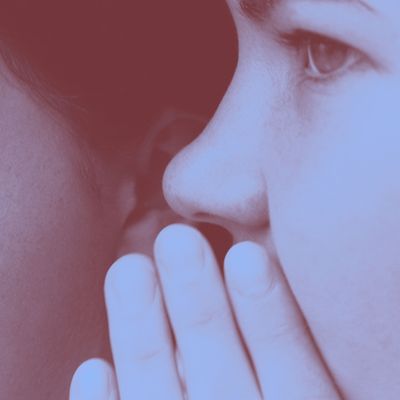
ASMR, a.k.a. “autonomous sensory meridian response,” a.k.a. (in some quarters, at least) whisper porn, is a subject of much fascination but little concrete understanding. As Jessica Roy explained last year, “The sound of whispering, for ASMR enthusiasts, produces a warm, tingly sensation, something like the frisson you might feel while listening to intense music.“ It’s a subtle euphoria that lulls those who experience it into an almost trancelike state of relaxation, telegraphing spinal shivers and spreading goosebumps across their skin.
ASMR enthusiasts may spend hours searching for ASMR videos online, as I can personally attest — my own habit was kicked off by a very relaxing voice on a guided-meditation cassette my mom gave me — but no one really knows why. Science has so far turned up approximately zilch that can explain, for example, why some people swoon when they hear the crinkling of wrapping paper, while others get chills only from a soothing voice like Bob Ross’s, and others appear to be immune to ASMR effects altogether.
Now, though, researchers have taken their first steps toward understanding this strange world. On March 26, Emma L. Barratt and Nick J. Davis, psychologists at Swansea University in the U.K., published the very first scientific paper on ASMR in the open-access journal PeerJ. “The fact that it was so wide-reaching went a long way to convincing me it was something that needed looking into, rather than a niche interest at a corner of the Web,” said Barratt.
Their study was, in part, an initial census of the ASMR community, or one slice of it at least. Nearly 500 participants, all of whom came from Facebook and Reddit ASMR groups, filled out a questionnaire about their ASMR viewing habits, why they watched the videos, and what triggers they responded to, among other things. The authors used the data to identify the sensation’s most common triggers: whispering (the trigger for the majority), personal attention (many ASMR videos are role-plays, in which the “ASMRtist” acts as a receptionist, aesthetician, or masseuse, among other care-taking characters), crisp sounds, and slow, deliberate movements (like towel folding). Most participants watched ASMR videos for relaxation, stress relief, and as a sleep aid. (Only 5 percent of ASMR enthusiasts reported watching the videos for sexual stimulation — a result I found odd given the high percentage of male YouTube commenters who vividly describe every need they’d like the soft-speaking woman in a video to fulfill.)
The paper also highlighted some potentially interesting connections between ASMR and two other, better known conditions: “flow states” and synesthesia. Davis felt that flow states, or the effortless “zone” athletes and workers sometimes find themselves in during period of heightened focus, had a natural connection to ASMR: For one thing, many ASMRtists appear to operate in a flowlike state when performing their roles in videos; plus, enthusiasts also experienced something like flow when watching those videos (again, I can attest — in my case it felt a bit like a runner’s high, albeit more calming, and was addictive in the same way). Sure enough, those who experienced flow states more often tended to respond to a greater number of ASMR triggers. “It may be that ASMR is brought about by obtaining a flowlike state, which is in part facilitated by witnessing others in such a state,” Barratt and Davis conclude.
As for synesthesia, or a condition in which one form of sensory input activates a separate sense (for instance, some people with synesthesia will associate a specific taste with a certain color), Davis also thought certain aspects of ASMR suggested a connection. “ASMR seems to be a very multisensory experience,” he said, “and I thought that being able to experience things in a very multisensory way — like with synesthesia — might promote the ASMR experience a bit.” The researchers did find some preliminary evidence of a connection: 5.9 percent of the ASMR enthusiasts they surveyed also reported synesthesia symptoms, versus 4.4 percent in the general population — a difference that may or may not turn out to be statistically significant in the long run.
Clearly, Barratt and Davis’s study had significant limits, starting with the fact that their sample was composed entirely of ASMR enthusiasts. So one of the biggest questions about ASMR effects — why some people experience them while others don’t — will have to wait for future research. They also seem to have left out some triggers. I was surprised to see “liquid sounds” (or some such description), my own strongest trigger, not included — especially considering numerous ASMRtists will chew gum, apply lip gloss, and even, well, stir liquids to create that effect (Barratt said she and her partner realize the list of triggers in the study is “not exhaustive”).
But the co-authors are aware of these limitations and seem eager to pursue further, more rigorous study of ASMR. Davis is interested in examining how noninvasive brain stimulation — his primary area of research — might be used to monitor and possibly enhance the ASMR experience, and both he and Barratt want to explore the relationship between ASMR and misophonia, its opposite (finding certain sounds very off-putting). They also hope to better break down how different sorts of voices stimulate different sorts of ASMR sensations. Finally, some of the respondents in their study claimed that ASMR alleviated chronic pain and improved their mood — two possibilities that also merit further research.
“There are others who are studying this, and this is just the first paper,” said Davis. “I suspect there will be many more in the next couple of years.” In the meantime, I’ll be heeding his advice and trying not to overthink my ASMR experiences too much — a friend of Davis’s says that the more she studies ASMR, the less she feels it.




